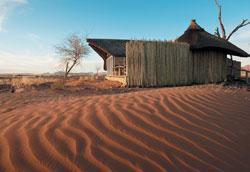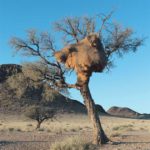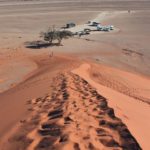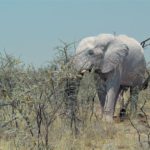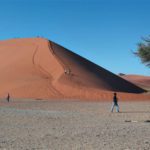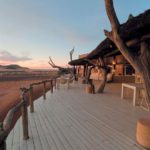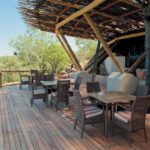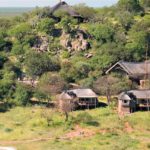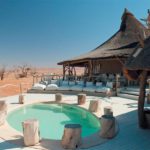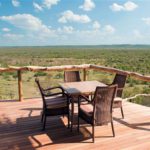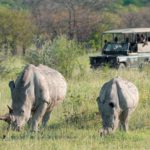Zaza Motha visits namibia and finds serene space and spectacular scenery
The sands stretch lazily over the Namib desert. Flying in a small plane over the barren land leaves you breathless with an overwhelming sense of space. The landscape below is painted with strokes of taupe and russet, while strips of charcoal black fleck the dunes. Each wave and bend of moulded sand tells a story that spans 55-million years. This, the world’s oldest desert, is extremely arid, yet many resilient creatures survive the climate. On the ground, dunes constantly transforming under winds blown off the Atlantic tower above you.
We’d flown by charter plane from Windhoek to Sossusvlei in the south,to visit an isolated wonderland created by Wilderness Safaris, called Little Kulala (“kulala” means “to sleep” in Oshiwambo, one of the local languages). The lodge is in the Kulala Wilderness Reserve, gateway to Namibia’s “Sand Sea”, where theworld’s tallest dunes meet the sky.The lodge blends in with the landscape and is difficult to spot from afar, and the interiors take one by surprise. Climate-controlled thatched rooms (called kulalas) have glass walls, so from your bed you can watch ostrich and springbok go by. As soon as I was settled, I looked for a TV set (a habitual relaxation mechanism on my part) and found nothing.
That’s right, no TV, no radio and poor reception for cellphones… but who needs these things when you have a fully stocked fridge and a setting that stretches the imagination. On the rooftop I found “sky beds” for sleeping under the stars. From the roof I looked out to the veiled mountains in the distance and absorbed the complete silence, so rare to us city dwellers that it seems almost deafening. In the evening, on a drive around the reserve, I saw one of nature’s wonders, a nest built by Namibian weavers, miniature birds that inhabit a massive communal structure.
From beneath you can see entrances leading to internal chambers. The nests are so heavy that they often break the acacia trees in which they are built. We stopped at the nearby Kulala Wilderness Camp, where I was amazed to see the “loo with a view”, exposed to the mountains. Its location might be securely private, but I didn’t risk it. Great spaces make for great appetite, so a gourmet dinner – French onion soup, oryx steak with roasted butternut, mashed potatoes with mustard seeds and broccoli, followed by marula mousse – was just the comfort I needed before dozing off. The Namibian wilderness is best explored on a guided safari tour, where animals are just an arm’s length away. I experienced this on our early-morning drive to Dune 45, loving the cold, stinging air and the game and birds we saw along the way.
When we stopped at the base of the dune, ant-sized human figures near its tip revealed the extent of its stature. Dune 45 is the most-climbed dune at Sossusvlei. Its larger relatives are called Big Daddy and Big Mama.Getting to the top didn’t look that hard, but like many who attempt this deceptive climb through shifting sands, I didn’t make it even halfway. Instead we took a short drive to Dead Vlei,a large salt pan. Agnes Tjirare, my tour guide, showed me the abundant iron content in the sand by running a magnet through it. The spiky iron particles race to the magnet and cling. The pan is an enormous white expanse dotted with the ancient black stumps of lifeless acacias. Its dry, wrinkled surface tells of a long life fully lived. Walking barefoot to our vehicle on the way back from Dead Vlei, however, was gruelling: the sand, previously delightfully cool, now felt like walking on a hot stove.
After a much-needed freshening-upback at the lodge, massage therapist Jeneth Ketji gently unleashed my tired back muscles before another delicious supper and some well-deserved sleep. Next morning we left by plane to explore Walvis Bay and Swakopmund with Willie van Wyk of African Leisure Tours. Walvis Bay, the hub of the fishing industry, has a section that looks over a lagoon populated by flamingos and seals, which could be described as the Beverly Hills of Namibia. Just off the coast between Walvis Bay and Swakopmund is a man-made island known as the bird rock. It is actually a guano platform on stilts, built in the early 1900s. It serves as a breeding ground for birds (mostly Cape cormorants) whose droppings are collected for use in cosmetic products.
In Swakopmund I enjoyed the buzz of being back in a city, though in a strange way I missed the desert. Swakopmund has the same retail stores and banks as South Africa, but the German influence can be felt in the cuisine and architecture. It is a German architectural paradise which includes medieval Romanesque with its semi-circular arches, Gothic with its pointed arches, renaissance, baroque, classical and art nouveau, which draws inspiration from traditional German printmaking. These styles are evident in buildings like Hohenzollern House, the Lutheran church and Swakopmund Prison, which (at least from the outside) must be the world’s most beautiful prison.
The cold coastal winds were unforgiving in their determination to keep me indoors, but this was no hardship since I was staying at the Swakopmund Boutique Hotel, close to the sea. Some restaurants one can try in Swakopmund are Café Treff, Café Anton, which serves traditional German confectionary, Brauhaus and Kücki’s Pap, well-known for its garlic steaks and seafood. On another charter plane from Swakopmund to Wilderness Safaris’ Ongava Lodge in the north of Namibia (close to Etosha National Park), I was again met by towering dunes. Lunch at Ongava was served on a deck overlooking the watering hole, which reminded me of city life in Johannesburg: springbok having their daily drink were surrounded by lion, elephant, giraffe, kudu and zebra. On the last day, I woke up to the sound of a roaring lion, which sounded, to me, like a raucous invitation to return.

